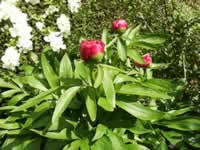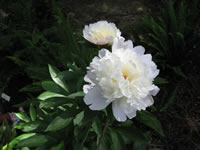How to Grow and Care for Peony PlantsPaeonia lactifloraThe herbaceous Peony has been cultivated in home gardens for over 600 years. Considering the beauty of the flower and the longevity of the plants, it's no wonder why they have long been a perennial favorite. Peony clumps may survive for up to as long as 50 years, so it is advisable to prepare the growing site very thoroughly before planting. Once established in the garden, Peony plants are reasonably free from maintenance and problems. |
|||||
|
|||||
|
The planting hole should be at least 18 inches deep and about 18 inches in diameter. At the bottom of the hole, add a 4 inch layer of organic matter such as compost, pine bark, or well-aged manure. A half cup of a good plant food (10-6-4), bone meal or superphosphate should be mixed into this layer. You should avoid adding fertilizer to the soil that will be in direct contact with the roots. Fill the hole half way with a mix of garden soil and compost, and then set the root division in place with the eyes facing upward. Spread the roots outward and evenly. Water thoroughly. Make certain that the eyes will be no deeper than two inches when the planting is completed, or your Peony may fail to bloom. If potted peonies are being planted, plant them at same level as they are growing in the pot. After the division or plant is in place, work the soil in around the roots, finish filling the hole, and then water again. If root divisions are planted in the spring, they may not bloom for up to two years. However, Peonies which are potted and already growing may bloom for you the first year when planted early enough in the spring. Feeding and Watering Your Peony PlantsPeonies should be fed in early spring and again halfway through the growing season. Cultivate a half cup of low nitrogen fertilizer (5-10-10) into the soil when new growth about 2 or 3 inches high.Use care not to damage the roots, and try to keep the fertilizer from direct contact with them. Over-fertilizing, especially with a high nitrogen plant food, results in weak stems and reduced flowering. Peonies are particularly partial to potash, and will benefit from the incorporation of a couple cups of fireplace ash into the soil in early spring. During the dry summer months, Peonies require regular, deep watering. A spring application of 2-4 inches of leafy, organic mulch will help to conserve the soil moisture and at the same time keep the soil cool and control weeds. This mulch must be removed and destroyed before winter and a new, fresh winter mulch of loose straw or evergreen boughs added, to help control disease. Larger Peony flowers will be produced if the side buds on each stem are removed as soon as they are visible. The terminal bud on each stem tip is left intact. To prevent the flowers from breaking or bending over during a strong wind or rain, provide a sturdy plant stake and tie the stem loosely to it with garden twine or strips of cloth. Remove the flowers as soon as they fade to prevent seed development, which will use up needed food reserves, and effect next years bloom. In the fall, after the foliage dies back, cut the stems back to three inches, remove and destroy them.
|
|||||
Search The Garden Helper:


